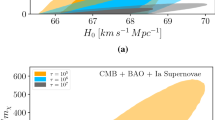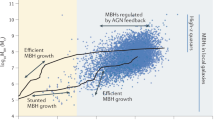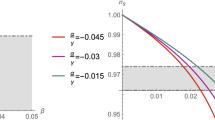Abstract
The fate of an evaporating black hole when it reaches the Planck mass is a matter for conjecture. Here, we propose that the cosmological dark matter consists of the Planck-mass remnants of evaporating primordial black holes. Such remnants would be expected to have close to the critical density if the black holes evaporating at the present epoch have the maximum density consistent with cosmic-ray constraints. The remnants are also candidates for the missing mass in the galactic halo. Primordial black holes of the required density may form naturally at the end of an inflationary epoch. Planck-mass relics would behave dynamically just like 'cold dark matter' and would therefore share the attractions of other 'cold' candidates. In addition, because the baryonic matter in black holes cannot participate in nucleosynthesis the limits on the baryonic content of the Universe set by primordial nucleosynthesis are circumvented.
This is a preview of subscription content, access via your institution
Access options
Subscribe to this journal
Receive 51 print issues and online access
$199.00 per year
only $3.90 per issue
Buy this article
- Purchase on Springer Link
- Instant access to full article PDF
Prices may be subject to local taxes which are calculated during checkout
Similar content being viewed by others
References
Hawking, S. W. Nature 248, 30–31 (1974).
Birrell, N.D. & Davies, P. C. W. Quantum Fields in Curved Space (Cambridge University Press, 1984).
Bunch, S. T. J. Phys. A. 14, L139–L143 (1981).
York, J. W. Jr in Quantum Theory of Gravity (ed. Christensen, S.) 135–147 (Hilger, London, 1984).
Markov, M. A. in Proc. 2nd Seminar in Quantum Gravity (eds Markov, M. A. & West, P. C.) 1–18 (Plenum, New York, 1984).
DeWitt, B. S. Phys. Rep. 19C, 297–357 (1975).
Wald, R. in Quantum Theory of Gravity (ed. Christensen, S.) 160–168 (Hilger, London, 1984).
Hawking, S. W. Communs. math. Phys. 55, 133–148 (1977).
Hawking, S. W. Phys. Rev. D14, 2460–2473 (1977).
Penrose, R. in General Relativity: An Einstein Centenary Survey (eds Hawking, S. W. & Israel, W.) 581–638 (Cambridge University Press, 1979).
Carr, B. J. & Hawking, S. W. Mon. Not. R. astr. Soc. 168, 399–415 (1974).
Carr, B. J. Astrophys. J. 201, 1–19 (1975).
Guth, A. Phys. Rev. D23, 347–356 (1981).
Linde, A. D. Phys. Lett. B108, 389–393 (1982).
Albrecht, A. & Steinhardt, P. Phys. Rev. Lett. 48, 1220–1223 (1982).
Fabbri, R., Lucchin, F. & Matarrese, S. Astrophys. J. 315, 1–11 (1987).
Kaiser, N. & Silk, J. Nature 324, 529–537 1086).
Silk, J. & Turner, M. S. Phys. Rev. D35, 419–428 (1987).
Starobinskii, A. A. Soviet Phys. JETP Lett. 42, 152–155 (1985).
Davis, M., Efstathiou, G., Fenck, C. S. & White, S. D. M. Astrophys. J. 292, 371–394 (1985).
Author information
Authors and Affiliations
Rights and permissions
About this article
Cite this article
MacGibbon, J. Can Planck-mass relics of evaporating black holes close the Universe?. Nature 329, 308–309 (1987). https://doi.org/10.1038/329308a0
Received:
Accepted:
Issue Date:
DOI: https://doi.org/10.1038/329308a0
This article is cited by
-
Cosmological gravitational waves from isocurvature fluctuations
AAPPS Bulletin (2024)
-
Nonstaticity with type II, III, or IV matter field in \(f(R_{\mu \nu \rho \sigma },g^{\mu \nu })\) gravity
General Relativity and Gravitation (2021)
-
Dark radiation and superheavy dark matter from black hole domination
Journal of High Energy Physics (2019)
-
Entropic corrected Newton’s law of gravitation and the loop quantum black hole gravitational atom
General Relativity and Gravitation (2016)
-
Corrected Hawking Temperature in Snyder’s Quantized Space-time
International Journal of Theoretical Physics (2015)
Comments
By submitting a comment you agree to abide by our Terms and Community Guidelines. If you find something abusive or that does not comply with our terms or guidelines please flag it as inappropriate.



